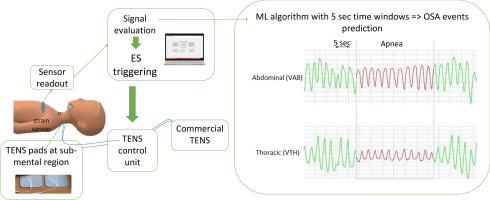当前位置:
X-MOL 学术
›
Microelectron. Eng.
›
论文详情
Our official English website, www.x-mol.net, welcomes your feedback! (Note: you will need to create a separate account there.)
Development of an automated system for obstructive sleep apnea treatment based on machine learning and breath effort monitoring
Microelectronic Engineering ( IF 2.3 ) Pub Date : 2020-07-01 , DOI: 10.1016/j.mee.2020.111376 V. Tsouti , A.I. Kanaris , K. Tsoutis , S. Chatzandroulis
Microelectronic Engineering ( IF 2.3 ) Pub Date : 2020-07-01 , DOI: 10.1016/j.mee.2020.111376 V. Tsouti , A.I. Kanaris , K. Tsoutis , S. Chatzandroulis

|
Abstract Obstructive sleep apnea (OSA) is characterized by repeated airway obstructions during sleep and affects about 35% of the population. Untreated OSA is associated with increased mortality and severe comorbidities. This fact, combined with the poor long-term compliance to the standard therapy, has led to an increased interest in alternative treatment options such as the electrical stimulation (ES) of the genioglossus muscle. In this work, we propose an automated non-invasive system for real-time monitoring of obstructive sleep apnea and treatment through ES of the genioglossus muscle. The closed-loop system includes a sensor to monitor breath effort from respiratory movement, a Transcutaneous Electrical Nerve Stimulation (TENS) device, and a program that analyzes the signal of the sensor and controls the whole system. The breath effort signal is first processed and then fed to a machine learning (ML) algorithm, which is a pattern recognition network. The whole analysis runs on a personal computer and used data from an open database of 12 patients in order to train the ML network and evaluate its performance. The breath effort signals were obtained from thoracic and abdominal inductance plethysmography recordings. OSA events were classified with an average true detection rate 81% ± 8% and 77% ± 11% for thoracic (VTH) and abdominal (VAB) sensor signals, respectively. The overall classification accuracies were on average 73% ± 5% for VTH and 74% ± 9% for VAB. An improvement is observed when both signals are considered (82% ± 7%).
中文翻译:

基于机器学习和呼吸努力监测的阻塞性睡眠呼吸暂停治疗自动化系统的开发
摘要 阻塞性睡眠呼吸暂停 (OSA) 的特点是睡眠期间反复出现气道阻塞,影响约 35% 的人口。未经治疗的 OSA 与死亡率增加和严重合并症有关。这一事实,加上对标准治疗的长期依从性较差,导致人们对替代治疗方案的兴趣增加,例如颏舌肌电刺激 (ES)。在这项工作中,我们提出了一种自动化的非侵入性系统,用于通过颏舌肌的 ES 实时监测阻塞性睡眠呼吸暂停和治疗。闭环系统包括一个传感器,用于监测呼吸运动引起的呼吸作用,一个经皮神经电刺激 (TENS) 设备,以及一个分析传感器信号并控制整个系统的程序。呼吸努力信号首先被处理,然后被馈送到机器学习 (ML) 算法,这是一个模式识别网络。整个分析在个人计算机上运行,并使用来自 12 名患者的开放数据库中的数据来训练 ML 网络并评估其性能。呼吸努力信号是从胸部和腹部电感体积描记记录中获得的。OSA 事件被分类为胸部 (VTH) 和腹部 (VAB) 传感器信号的平均真实检测率分别为 81% ± 8% 和 77% ± 11%。VTH 的总体分类准确度平均为 73% ± 5%,VAB 为 74% ± 9%。当考虑两个信号时,观察到改进 (82% ± 7%)。整个分析在个人计算机上运行,并使用来自 12 名患者的开放数据库中的数据来训练 ML 网络并评估其性能。呼吸努力信号是从胸部和腹部电感体积描记记录中获得的。OSA 事件被分类为胸部 (VTH) 和腹部 (VAB) 传感器信号的平均真实检测率分别为 81% ± 8% 和 77% ± 11%。VTH 的总体分类准确度平均为 73% ± 5%,VAB 为 74% ± 9%。当考虑两个信号时,观察到改进 (82% ± 7%)。整个分析在个人计算机上运行,并使用来自 12 名患者的开放数据库中的数据来训练 ML 网络并评估其性能。呼吸努力信号是从胸部和腹部电感体积描记记录中获得的。OSA 事件被分类为胸部 (VTH) 和腹部 (VAB) 传感器信号的平均真实检测率分别为 81% ± 8% 和 77% ± 11%。VTH 的总体分类准确度平均为 73% ± 5%,VAB 为 74% ± 9%。当考虑两个信号时,观察到改进 (82% ± 7%)。OSA 事件被分类为胸部 (VTH) 和腹部 (VAB) 传感器信号的平均真实检测率分别为 81% ± 8% 和 77% ± 11%。VTH 的总体分类准确度平均为 73% ± 5%,VAB 为 74% ± 9%。当考虑两个信号时,观察到改进 (82% ± 7%)。OSA 事件被分类为胸部 (VTH) 和腹部 (VAB) 传感器信号的平均真实检测率分别为 81% ± 8% 和 77% ± 11%。VTH 的总体分类准确度平均为 73% ± 5%,VAB 为 74% ± 9%。当考虑两个信号时,观察到改进 (82% ± 7%)。
更新日期:2020-07-01
中文翻译:

基于机器学习和呼吸努力监测的阻塞性睡眠呼吸暂停治疗自动化系统的开发
摘要 阻塞性睡眠呼吸暂停 (OSA) 的特点是睡眠期间反复出现气道阻塞,影响约 35% 的人口。未经治疗的 OSA 与死亡率增加和严重合并症有关。这一事实,加上对标准治疗的长期依从性较差,导致人们对替代治疗方案的兴趣增加,例如颏舌肌电刺激 (ES)。在这项工作中,我们提出了一种自动化的非侵入性系统,用于通过颏舌肌的 ES 实时监测阻塞性睡眠呼吸暂停和治疗。闭环系统包括一个传感器,用于监测呼吸运动引起的呼吸作用,一个经皮神经电刺激 (TENS) 设备,以及一个分析传感器信号并控制整个系统的程序。呼吸努力信号首先被处理,然后被馈送到机器学习 (ML) 算法,这是一个模式识别网络。整个分析在个人计算机上运行,并使用来自 12 名患者的开放数据库中的数据来训练 ML 网络并评估其性能。呼吸努力信号是从胸部和腹部电感体积描记记录中获得的。OSA 事件被分类为胸部 (VTH) 和腹部 (VAB) 传感器信号的平均真实检测率分别为 81% ± 8% 和 77% ± 11%。VTH 的总体分类准确度平均为 73% ± 5%,VAB 为 74% ± 9%。当考虑两个信号时,观察到改进 (82% ± 7%)。整个分析在个人计算机上运行,并使用来自 12 名患者的开放数据库中的数据来训练 ML 网络并评估其性能。呼吸努力信号是从胸部和腹部电感体积描记记录中获得的。OSA 事件被分类为胸部 (VTH) 和腹部 (VAB) 传感器信号的平均真实检测率分别为 81% ± 8% 和 77% ± 11%。VTH 的总体分类准确度平均为 73% ± 5%,VAB 为 74% ± 9%。当考虑两个信号时,观察到改进 (82% ± 7%)。整个分析在个人计算机上运行,并使用来自 12 名患者的开放数据库中的数据来训练 ML 网络并评估其性能。呼吸努力信号是从胸部和腹部电感体积描记记录中获得的。OSA 事件被分类为胸部 (VTH) 和腹部 (VAB) 传感器信号的平均真实检测率分别为 81% ± 8% 和 77% ± 11%。VTH 的总体分类准确度平均为 73% ± 5%,VAB 为 74% ± 9%。当考虑两个信号时,观察到改进 (82% ± 7%)。OSA 事件被分类为胸部 (VTH) 和腹部 (VAB) 传感器信号的平均真实检测率分别为 81% ± 8% 和 77% ± 11%。VTH 的总体分类准确度平均为 73% ± 5%,VAB 为 74% ± 9%。当考虑两个信号时,观察到改进 (82% ± 7%)。OSA 事件被分类为胸部 (VTH) 和腹部 (VAB) 传感器信号的平均真实检测率分别为 81% ± 8% 和 77% ± 11%。VTH 的总体分类准确度平均为 73% ± 5%,VAB 为 74% ± 9%。当考虑两个信号时,观察到改进 (82% ± 7%)。


























 京公网安备 11010802027423号
京公网安备 11010802027423号